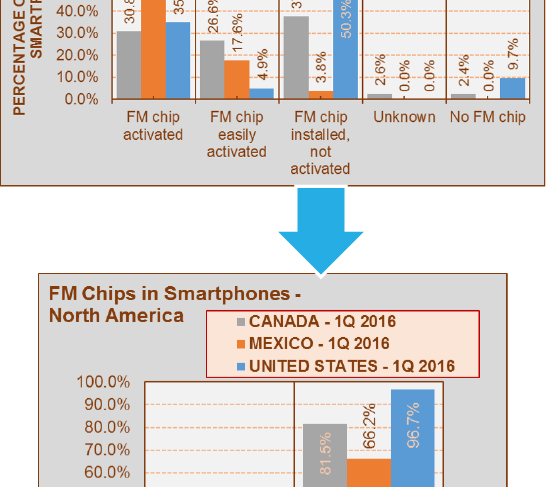
TORONTO and WASHINGTON, DC – Only 30% of the top selling smartphones in Canada have their FM chip activated, and that excludes iPhones, says new research from the North American Broadcasters Association (NABA).
The organization said that most of the top-selling smartphones in Canada, the U.S. and Mexico include an FM chip, meaning the devices can receive free, over-the-air FM radio signals if the chip is activated. But for a variety of reasons, these FM chips are often not activated, most notably in all of Apple’s iPhone products (which are top sellers).
In Q1 2016 in Canada, 37.7% of smartphones have an FM chip installed but not activated, including 81.5% of Apple devices and 18.5% of Android smartphones. That compares to 50.3% in the U.S. (96.7% Apple and 3.3% Android) and just 3.8% in Mexico (66.2% Apple and 33.8% Android).
In support of active FM chips, NABA said that it worked with the National Association of Broadcasters to study quarterly smartphone sales by device model to determine the top-selling devices, and then conducted a "tear-down" of the phone to establish the level of FM chip activation based upon the following five categories:
– FM chip activated: FM chip is activated in these smartphones and available for use by consumers. Headset cord use is required since headset cord acts as FM antenna (audio is typically available either from smartphone speakers or headset);
– FM chip easily activated: FM chip is activated on the same model in another country so no hardware changes would likely be required to activate in this country;
– FM chip installed, not activated: FM chip is included in these smartphones but either a hardware or software modification would be required to activate the FM chip;
– Unknown: Insufficient data on smartphone to be able to establish whether FM chip is installed; and
– No FM chip: FM chip not included in smartphone.
“NABA believes that providing statistical data on FM chip activation in smartphones for North America is an important step for raising awareness of this technology among radio broadcasters and consumers,” said NABA director-general Michael McEwen, in the news release.
The data is available here on the NABA web site.




